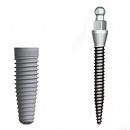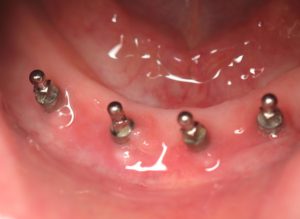Presented by Dr. Steven Sullivan, DDS, Professor and Chair, University of Oklahoma at the AAOMS Dental Implant conference In December, 2009)
Summary: Mini implants, often offered by less experienced dentists as a quick and less costly solution to replacing missing teeth, have a high degree of complications and failure and therefore are not recommended for long-term tooth replacement. Only standard size implants should be used for teeth replacement to achieve long-term success and longevity.
Key Facts About Mini Implants:
Small diameter implants have very limited clinical use and currently are only approved as a transitional implant for mandibular dentures. The claims by companies that have basically targeted general dentists are not supported in well designed studies, and there is no dependable evidence-based data in the literature. They have high rates of failure, and very limited in their clinical use, and do not provide patients with the results they expect. The companies do not seem to support such studies and have not been collaborating with the scientific community.
It is recommended that patients only have standard size implants for replacement of missing teeth with long term prognosis.
About Mini Implants
Mini implants are thin implants that have gained some popularity because of their simplicity and low cost. However, they are associated with many complications mainly because of misuse. The general rational for development of small diameter implants was the simplicity of insertion, cost effectiveness, and clinical effectiveness. The mini implant market share has increased greatly from $14 million in 2005 to over $55 million in 2010. They are mainly purchased and placed by general dentists (who are the main target market) and very small number of specialists. They have been sold to over 18,000 dentists globally.
Currently, mini implants are FDA approved only as a transitional implant for mandibular denture stabilization. Off-label use has been utilized by some clinicians but there is no data or evidence-based support for their use and they are not considered the standard of care. This has resulted in legal implications.
Implant Characteristics:
- Design features: O-ball or square prosthetic head, tapered tip straight wall body, inserted by cortical perforation, self advancing thread resulting in lateral compression, 1.8 mm – 2.4 mm diameter
- Surface may be smooth or grit blasted, but they can be easily removed as they are not integrated
- Prosthetic components are basically various O-ring housing
- Insertion protocol: cortical perforation, inserted with hand instrument, immediately loaded
Alternate Uses (off-label):
- Maxillary denture retention- No data on effectiveness, bone quality and implant stability are issues- very high failure rate
- Single tooth restorations- No data- high failure rates
- Bail-out situations- in narrow ridge- No data- high failure rates
Mini implants may be offered to you elsewhere because they are cheaper and easier to place than regular implants. However, mini implants are rarely successful in the long term and are associated with many complications such as infection or fractures.
Common Complications:
- Poor angulation and spacing- path of insertion issues, hygiene problems, soft tissue problems
- Breakage of implant- 55-60 Ncm to failure, fracture at the neck of the implant most common, often left in place
- Loss of fixture- very common- High failure especially if mandible bone height is less than 12 mm
- FOM hematoma due to poor angulation and perforation through lingual plate
Disadvantages:
- Not expandable to allow for a more sophisticated prosthesis
- Not applicable for small mandibles
- Failure rate higher than conventional implants
Are They Effective:
- No good studies have been done on long term success
- High failures in short mandibles
- Literature review: Very little and poor (literature recounts of less than 6 months)

